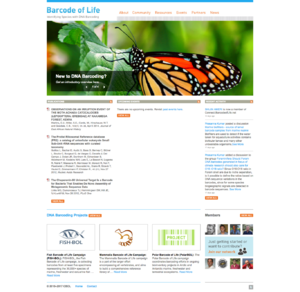Barcode of life
Autodefinidos
The International Barcode of Life project (iBOL) is the largest biodiversity genomics initiative ever undertaken. Hundreds of biodiversity scientists, genomics specialists, technologists and ethicists from 25 nations are working together to construct a richly parameterized DNA barcode reference library that will be the foundation for a DNA-based identification system for all multi-cellular life. In the first phase of operations (2010-2015), iBOL collaborators will barcode five million specimens representing 500,000 species. During construction of the barcode library, iBOL participants will also be building the infrastructure needed to use it in real-world situations such as conservation, ecosystem monitoring, forensics and control of agricultural pests and invasive species.
Descripción
The Consortium for the Barcode of Life (CBOL) is an international initiative dedicated to supporting the development of DNA barcoding as a global standard for species identification. CBOL's Secretariat Office is hosted by the National Museum of Natural History, Smithsonian Institution, in Washington, DC. Barcoding was proposed in 2003 by Prof. Paul Hebert of the University of Guelph in Ontario as a way of distinguishing and identifying species with a short standardized gene sequence. Hebert proposed the 648 bases of the Folmer region of the mitochondrial gene cytochrome-C oxidase-1 as the standard barcode region. Dr. Hebert is the Director of the Biodiversity Institute of Ontario, the Canadian Centre for DNA Barcoding, and the International Barcode of Life Project (iBOL), all headquartered at the University of Guelph. The Barcode of Life Data Systems (BOLD) is also located at the University of Guelph.
CBOL was created in May 2004 with support of the Alfred P. Sloan Foundation. Since then more than 200 organizations from more than 50 countries have joined CBOL and agreed to put their barcode data in a public database. CBOL promotes DNA barcoding through workshops, working groups, international conferences, outreach meetings to developing countries, planning meetings for barcoding projects, and production of outreach material to raise awareness of barcoding. CBOL's Database Working Group developed the data standard that GenBank, the European Bioinformatics Institute, and the DNA Data Bank of Japan have endorsed. CBOL's Plant Working Group proposed matK and rbcL as the standard barcode regions for land plants; CBOL approved this proposal in late 2005. The Fungal Working Group has identified ITS as the best barcode region for fungi, and CBOL's Protist Working Group is analyzing candidate regions for protistan groups. CBOL has also created Connect, a social network for the barcoding community. CBOL helped to plan and launch the global campaigns to barcode all species of fish and birds, and socioeconomically important groups like fruitflies.
One of CBOL's primary contributions to the success of barcoding has been its outreach efforts to government agencies (agriculture, environment, conservation, and others) and international organizations (CITES, Convention on Biological Diversity, Food and Agriculture Organization) that could benefit from barcoding.
Enlaces
URL: http://www.barcodeoflife.org
Wayback Machine: http://web.archive.org/web/20160811000914/http://www.barcodeoflife.org
Wikipedia: https://en.wikipedia.org/wiki/Consortium_for_the_Barcode_of_Life
